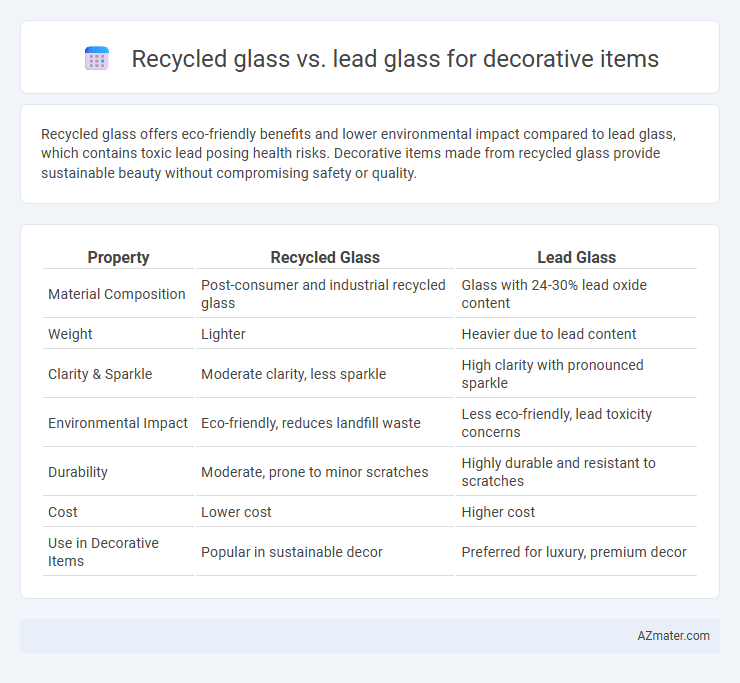Recycled glass offers eco-friendly benefits and lower environmental impact compared to lead glass, which contains toxic lead posing health risks. Decorative items made from recycled glass provide sustainable beauty without compromising safety or quality.
Table of Comparison
| Property | Recycled Glass | Lead Glass |
|---|---|---|
| Material Composition | Post-consumer and industrial recycled glass | Glass with 24-30% lead oxide content |
| Weight | Lighter | Heavier due to lead content |
| Clarity & Sparkle | Moderate clarity, less sparkle | High clarity with pronounced sparkle |
| Environmental Impact | Eco-friendly, reduces landfill waste | Less eco-friendly, lead toxicity concerns |
| Durability | Moderate, prone to minor scratches | Highly durable and resistant to scratches |
| Cost | Lower cost | Higher cost |
| Use in Decorative Items | Popular in sustainable decor | Preferred for luxury, premium decor |
Introduction to Recycled Glass and Lead Glass
Recycled glass is produced by melting down post-consumer or industrial glass waste, offering an eco-friendly alternative that reduces raw material consumption and landfill impact. Lead glass, also known as crystal glass, contains lead oxide which enhances its weight, brilliance, and refractive properties, making it highly valued for decorative items with luxurious appeal. The choice between recycled glass and lead glass depends on environmental considerations and desired aesthetic qualities in decorative applications.
Manufacturing Processes of Recycled vs. Lead Glass
Recycled glass for decorative items is produced by melting post-consumer glass at lower temperatures to conserve energy, incorporating cullet with raw materials, which reduces manufacturing costs and environmental impact. Lead glass manufacturing involves adding lead oxide to the glass melt, significantly increasing the refractive index for enhanced brilliance but requiring higher processing temperatures and careful handling due to lead's toxicity. The production process of recycled glass emphasizes sustainability and energy efficiency, whereas lead glass manufacturing prioritizes optical quality and clarity through specialized raw material composition and precise temperature control.
Environmental Impact: Recycled Glass vs. Lead Glass
Recycled glass significantly reduces environmental impact by lowering energy consumption and minimizing landfill waste compared to lead glass, which involves toxic lead content harmful to ecosystems. Lead glass production releases hazardous substances that pose long-term risks to soil and water quality, whereas recycled glass promotes sustainable resource use and supports circular economy principles. Choosing recycled glass for decorative items aligns with eco-friendly practices by reducing pollution and conserving natural raw materials.
Health and Safety Considerations
Recycled glass contains no harmful chemicals, making it a safer option for decorative items in homes and public spaces, as it reduces exposure to toxins commonly found in lead glass. Lead glass, also known as crystal, can leach lead particles, posing health risks, especially in environments with children or frequent handling. Choosing recycled glass minimizes environmental hazards and enhances indoor air quality by avoiding lead contamination.
Aesthetic Qualities and Visual Appeal
Recycled glass offers a unique aesthetic with subtle variations, creating an organic, textured appearance that enhances decorative items with an eco-friendly charm. Lead glass, renowned for its high refractive index and clarity, delivers exceptional brilliance and sparkle, making decorative pieces visually striking and luxurious. The choice between recycled and lead glass depends on the desired visual effect--rustic and sustainable elegance versus refined clarity and luminance.
Durability and Longevity Comparison
Recycled glass decorative items typically exhibit moderate durability and resistance to scratches but may possess slightly lower strength compared to lead glass due to differences in density and composition. Lead glass, infused with lead oxide, offers superior durability, higher refractive index, and enhanced longevity, making it more resistant to chipping and breakage over extended periods. The presence of lead increases the material's hardness and resilience, which contributes to lead glass's preferred status for high-end decorative items requiring long-lasting brilliance.
Cost Analysis: Affordability of Recycled vs. Lead Glass
Recycled glass offers a significantly lower cost compared to lead glass due to reduced raw material expenses and energy consumption during production. Lead glass involves higher manufacturing costs because of the specialized materials and processes required to incorporate lead oxide for enhanced clarity and brilliance. Choosing recycled glass for decorative items ensures affordability without sacrificing aesthetic appeal, making it a cost-effective alternative for environmentally conscious consumers.
Popular Decorative Item Applications
Recycled glass is commonly used in decorative items such as colorful mosaics, vases, and garden ornaments, valued for its eco-friendly properties and vibrant hues. Lead glass, known for its high refractive index and brilliance, is preferred for luxury decorative items like chandeliers, fine glassware, and intricate figurines that require clarity and sparkle. Both types serve distinct aesthetic purposes in decorative applications, with recycled glass emphasizing sustainability and lead glass highlighting elegance and optical clarity.
Consumer Trends and Market Preferences
Recycled glass is gaining traction among environmentally conscious consumers due to its sustainability and lower carbon footprint, driving a shift in market preferences toward eco-friendly decorative items. Lead glass, known for its clarity and brilliance, remains favored for luxury decor enthusiasts valuing aesthetic quality and traditional craftsmanship. Industry reports indicate a growing demand for recycled glass products in mass-market segments, while lead glass maintains a niche presence in premium, artisanal collections.
Choosing the Right Glass for Decorative Items
Recycled glass offers an eco-friendly choice for decorative items, reducing environmental impact through lower energy consumption and waste. Lead glass, known for its high refractive index and brilliance, provides superior clarity and weight, enhancing visual appeal in luxury decorations. Selecting the right glass depends on balancing sustainability goals with the desired aesthetic quality and durability of the decorative piece.

Infographic: Recycled glass vs Lead glass for Decorative item
 azmater.com
azmater.com